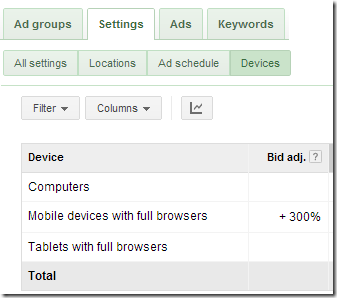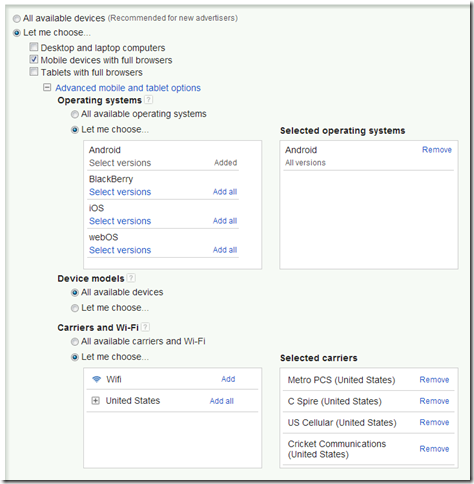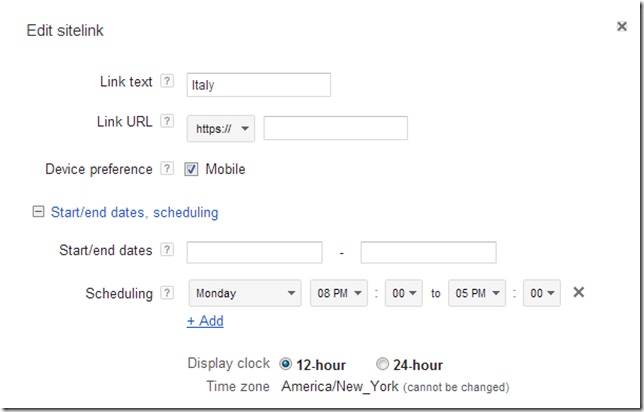Should You Upgrade To AdWords Enhanced Campaigns?
Google made a huge splash last week when they announced Enhanced Campaigns. There have been both positive and negative reactions to the announcement. If you haven’t heard about the changes, here is the quick, bullet-point list: The ability to set mobile-specific bids will be removed (you can do bid adjustments at the campaign level) The […]
Google made a huge splash last week when they announced Enhanced Campaigns. There have been both positive and negative reactions to the announcement.
If you haven’t heard about the changes, here is the quick, bullet-point list:
- The ability to set mobile-specific bids will be removed (you can do bid adjustments at the campaign level)
- The ability to target specific mobile devices and carriers will be removed
- The ability to specifically target tablets will be removed and bundled with desktop campaigns
- You can now control ad extensions by ad group
- You can now use ad scheduling for sitelinks
- You can do bid changes by geography (like mobile, this is a simple plus or minus percentage)
Some of these changes are excellent, such as ad group level ad extensions. Others will upset some marketers because they are going to lose lots of mobile targeting options.
Instead of getting on a soapbox and talking about how good or bad the changes are, I’m going to focus on whether or not you should upgrade immediately or hold off upgrading. Eventually, you will have to upgrade to Enhanced Campaigns, but you have several months before being forced to upgrade. Today, we’ll examine what accounts should be upgrading right away versus waiting to make the changes.
Who Should Wait A Long Time To Upgrade
1. Sophisticated Mobile Accounts
If you are running sophisticated mobile campaigns, you will want to wait to upgrade. I have some accounts where I bid differently by device; device and carrier; and even some that are segmented by device, carrier and geography.
This type of granular control will be completely removed. For these types of accounts, you will want to wait and see if Google makes any changes to the targeting before you must switch to Enhanced Campaigns, and if not, you will want to really think through your upgrade strategy of combining campaigns together.
2. Mobile Only Accounts
It is not uncommon to see small accounts only target mobile devices. These accounts often have small to medium spends, and they are focused on phone calls. When you examine their spends, they can be profitable by only spending their money on mobile campaigns, and they don’t even run ads on desktops.
In the new world of Enhanced Campaigns, you cannot only target mobile devices. You will set your bids at the keyword or ad group level as normal, and then you can choose to override that bid for mobile devices by decreasing your bid up to 100% (which means you will not be shown on mobile as your bids will be zer0); or, you can raise your bids up to 300%.
That means if you were bidding $15 per click on a mobile device, you must now bid at least $5 for desktop clicks and set your bid boost to 300%. You are going to spend some money on desktops; and therefore, your overall profits will probably decline in this particular instance. These accounts should wait to upgrade.
3. Tablet Optimized Websites
You cannot target tablets differently from desktops at all. This means that you cannot set different destination URLs for tablets. So, if you have made a tablet optimized website, you will need to make sure that your site detects the tablet and redirects the user to the tablet site.
4. Vastly Different Desktop & Tablet CPAs
I work on some accounts where tablet clicks are much more valuable than desktop clicks. I work on some where they are about the same. I work on others where tablets have been disabled as they are so much worse than desktop clicks.
With Enhanced Campaigns, you cannot treat tablets and desktops separately, including bid adjustments. Therefore, for accounts with vastly different desktop and tablet CPAs, you will need to start working toward blended bids before you upgrade.

Bid adjustments are only by mobile devices; not for tablets.
Phone Specific Apps
I do want to clarify one point of confusion. I’ve heard from app makers that they are going to have problems promoting their products; and to some degree, this might be an issue. However, you can make app ads that are only shown on an iOS or Andriod device (sorry, no windows targeting yet). So, for your app install, you can target just the device type.
However, if you also run ads for your app that go to your website to showcase how to use the app, those ads will show on any device type. So, if you are only using app ads, upgrading is not going to affect you. If you are using app and regular text ads, then you might wait to upgrade.
These are the types of accounts that should wait to upgrade. There are other account types that will benefit from account upgrades right away.
Who Should Upgrade Now?
1. Accounts Doing Very Little Mobile Targeting
The downsides to the new Enhanced Campaigns are mostly around mobile. The upsides are bid adjustments and great control over extensions. Therefore, if you are doing very little or no mobile, there isn’t any downside to upgrading to enhanced accounts.
2. Accounts Struggling With Geographic Bidding
Almost every account has different CPAs and conversion rates by geography. You can see this data in the dimensions tab:
In this account, the CPAs range from $45 to $91 in their top 9 converting cities by absolute conversions. Therefore, this account first did some segmentation by geography into high, medium, and low performing areas in order to set different bids by region. The keywords and ads are identical for each region – only the bids change.
When you make some broad statements that have many exceptions about geographic targeting, most accounts fall into one of a few types:
- Targeting a small area
- A different campaign for every geography to control bids (but not ad changes)
- A different campaign for every geography to control ads (and maybe bids)
- The campaigns are national, or large regions, and even though performance changes by region, you don’t bid separately by region
With the new structure, you can set bid changes by geography for the same keywords by only using one campaign and bid boosts.
Accounts that have struggled with taking advantage of geographic data will benefit from these changes and will see benefits in upgrading their campaigns.
3. Accounts Segmented By Extension Usage
Ad extensions were campaign level only. Therefore, some accounts are segmented based upon extension usage. If you wanted different site links to appear for certain keywords and not others, then you needed to put these keywords in their own campaigns.
If you wanted one ad to use a location extension, but you didn’t want that same extension in another ad group in the same campaign, then you needed two campaigns. This caused some accounts to grow out of control just because of the extension usage.
The new structure allows you to control most extensions at the campaign or ad group level. Some extensions, such as social, are still only at the campaign level. You can designate some extensions as mobile-preferred and even set up ad scheduling for some extensions, such as sitelinks.
Conclusion
These are some of the more common reasons I’m seeing to upgrade or hold off upgrading.
There are more reasons to upgrade or to postpone your upgrade. For instance, if you have several thousand campaigns, even if you aren’t doing any mobile advertising, you want to really dig into your tablet and desktop data, conversion rates by geography, keyword overlap, and more before you decide to upgrade and possibly combine campaigns. In that case, it’s not an issue of not wanting to upgrade, it is a matter of thinking through your upgrade plan.
In other cases, when you look at a desktop-only e-commerce site that can now change bids by geography and control extensions by ad group, there is no reason, except for planning, to hold off on the upgrade.
Once you are ready to upgrade, what I would suggest is not immediately upgrading your campaigns at that moment in time. Instead, make a new campaign (it can be paused; it doesn’t have to be live) so you can play with how the bidding changes will work and how the extensions will be controlled. Get some firsthand experience. Once you see how you can control the extensions and the possibilities for bid changes, then think through how you can take advantage of the changes.
Once you are ready to take advantage of the changes, or mitigate the risks in the case of sophisticated mobile advertisers, then feel free to upgrade to the new enhanced campaigns.
Contributing authors are invited to create content for Search Engine Land and are chosen for their expertise and contribution to the search community. Our contributors work under the oversight of the editorial staff and contributions are checked for quality and relevance to our readers. The opinions they express are their own.
Related stories



